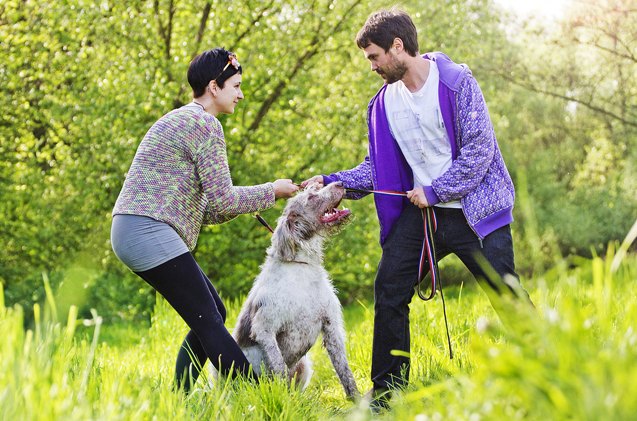The P.E.T.S. Plan – Four Steps To Divorcing With Pets

Divorce isn’t easy – especially when pets are involved. If both parties want guardianship of the dog, what options do you have? Debra Vey Voda-Hamilton, principal of Hamilton Law and Mediation, takes us through the four steps of the P.E.T.S. Plan – your guide to divorcing with pets.
Those of us who live with pets recognize how they enhance our lives. In the US 63% of American households own a pet. In 2014, $55 billion was spent on pet care, food and pet products. In a recent survey, 49% of pet owners described their pet as a family member, 49% said their pet was a companion and only 2% referred to them as ‘property.’
What happens when a dispute arises over a pet during a divorce or the break up of a relationship? Under the law in most states pets are property. In a recent New York case Travis v Murray, 2013 NY Slip Op 23405, the court issued a groundbreaking decision on the question of who gets the dog. The good news was that the court ordered a hearing to decide sole custody of the dog in this divorce. The bad news was that for most pet owners, the perimeters set in this hearing were heartbreaking. The judge ordered the parties to decide who would have sole ownership of the dog. The judge refused to entertain a discussion of co-ownership or visitation. Courts will not entertain custody and visitation of something they see as a chair or picture. You can sometimes receive value to relinquish your proven ownership right or you can lose your ownership rights altogether. The New York court hoped the parties would work out some visitation or continued connection with the non-owning pet parent after the problem of ownership was decided. It is unlikely, after an emotionally charged litigious battle that people will sit down and work out how to be kind to each other and share their dog.
Most couples, whether married or in a relationship, feel an attachment to the pets that were a part of that relationship. They see them as family members or companions. Be it a cat, dog, bird, horse or iguana, both parties feel some level of affection for the animal. This is why you should make a P.E.T.S. Plan. You create the directives for the care of your pet before your relationship is at the brink of disaster. In kinder times you address and agree upon what the best future for your beloved companion will be if the status quo in your relationship changed. This way the pet is taken out of the emotional equation.
The following four steps to divorcing with pets – P.E.T.S. – will encourage discussion, evaluation and agreement. Each step is easy and provides all parties with peace of mind regarding their future with their pet. No surprise ransom demands, belligerent arguments or litigation. You planned for the best outcome for all involved, including your pet.
P: Make a Pre/Post Nuptial/Relationship Agreement
During happier times, acknowledge the love each of you has for your furry companion. Decide, in writing, how you will stay a part of their life. If both humans go their separate ways, planning ahead with an agreement that addresses the shared custody of the dog will go a long way toward making everyone’s life, especially the animal’s, easier.
Recognize that a pet thrives with its primary owner. However, if that owner is unavailable due to death, disability, disaster, delay or disease, the secondary parent is a much better choice than a stranger in the pet’s mind. They know this person.
In lieu of their primary caregiver they will feel more at ease with the ex. If they need to stay for a weekend of travel, a week of vacation or months due to illness or disability, this home should be made available to them. You may never want to see your ex again but your pet may feel differently. Animals do not take sides and often adjust to change better with a person they know.
As always, these pre/post relationship agreements should be in writing. My practice is full of people who thought they had come to an agreement about shared custody only to find, since it was not in writing, long ago discussions and current emotions can play tricks on memories.
E: Engage in the Pet Conversation Immediately
When you bring animals into your life, start talking about their future care if something should happen to one or both of you. It may seem counter-intuitive, since pets are usually acquired during good times in a relationship. This is exactly why you should address questions involving a pet’s future. Pet parents are likely to be honest about how much they want to keep the pet in their lives going forward.
Clients run the gamut on how they visualize keeping a pet in their life. The time, cost and difficulty of owning a pet alone is rarely addressed in the emotion-laden battle for pet custody. Then reality sets in. How do you manage sharing your pet? How will they affect your new life? Will you be able to find pet friendly accommodations? Do you work out of your home? Can you bring the dog/cat to work? How will you afford a dog walker or routine pet vet care? What happens if a vet emergency occurs? Most people wish they had engaged in a deeper pet conversation and had been more open to the concept of sharing, after the fight for custody is settled.
Yet many exs burn the bridge of future discussions about a pet, and in the end that seriously affects the pet. Had the conversation about shared custody been engaged in earlier, the remaining pet connection and communication, outside the anger of a relationship break up, would enable one to call upon the other to help in an emergency.
T: Take Your Time
Now that you have opted to engage in the pet conversation, take your time in making any decisions and revisit agreements yearly. Things change. Once an agreement is made it can always be reevaluated. Lives change, priorities change and so does an individual’s ability to care for a pet. Yet, if you keep ‘who will’ and ‘how to’ about the future care of your pet on the discussion table the best outcome for all will always be your priority.
Taking time to look at every aspect of pet ownership, the tasks you love doing and the unglamorous ones, maintains a healthy respect for the ongoing responsibility of the primary caregiver.
S: Solve for the Best Interest of All
This is the common theme throughout each of the four directives. If you remain focused on what is best for each of you, your pet included, these discussions will be seen less as a contemplation of bad times ahead and more about maintaining the good times going forward. Take a deep breath, look at the whole picture and solve for what you think you want. Then, look at what you can actually do.
People are often told that they own a pet because they bought it or were the better parent. They will then fight to the death to prove that they are the primary owner or that they took better care of the pet. The only one who wins this battle is the attorney who gets paid to hold up their client’s view of their pet ownership. (Note: As a litigating attorney I felt obligated to tell my clients their legal rights regarding their property ownership in a beloved pet. That discussion might not support the best interest of all involved. The law requires your attorney to represent you zealously. What is good for all may not be the best outcome for a single client. This is the reason I mediate and no longer litigate these kinds of disagreements.)
In reality, the pet loves both caregivers, maybe one more than the other, but both in a pinch. If the best outcome for your pet is to be with you or your ex keep that in mind during these discussions. Don’t be side tracked by what anyone says about legal ownership of the pet. Keep the peaceful solution of this problem for all involved at the forefront of your process.
Debra Vey Voda-Hamilton is the principal of Hamilton Law and Mediation (HLM). Debra provides an alternative means of resolving disagreements between pet enthusiasts over misunderstandings, misstatements or oversights. She helps owners deal with neighbors over barking dog and divorcing couples arranging pet custody agreements. She enables a less heated conversation to take place between vets and their clients, condo/coop – tenant and management and pet information or product providers and their readers or clients. Her mediation practice provides a neutral ground on which to have the conversation you want to have while peacefully retaining a relationship among the parties. She works with everyone who wants to further their passion involving pets while reducing their exposure to conflict and litigation.You can reach Debra at 914-273-1085 or on her website at www.hamiltonlawandmediation.com

More by Debra Vey
























